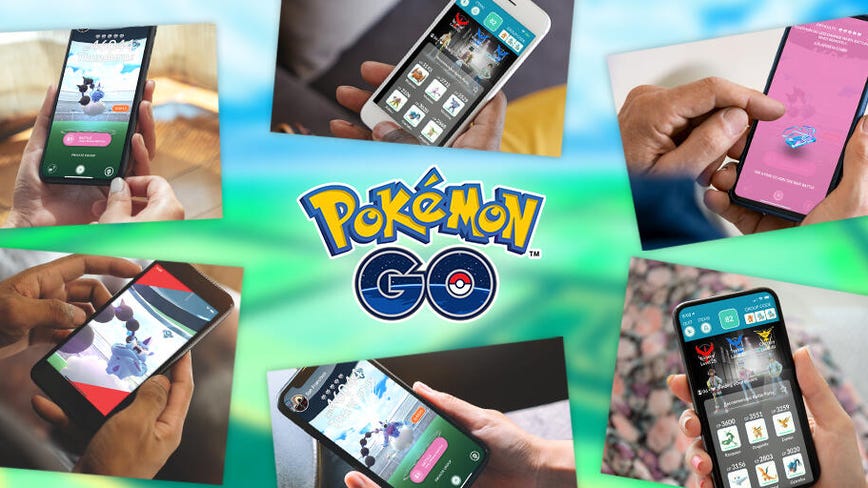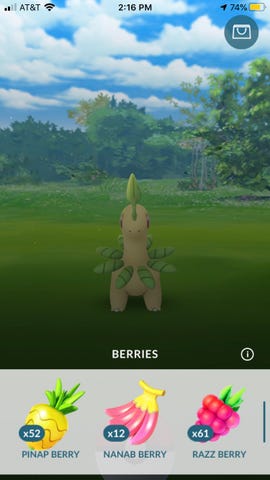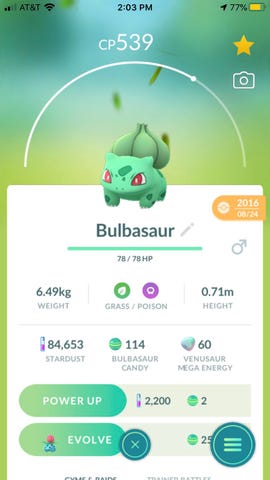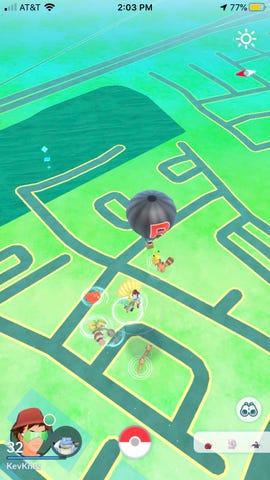Pokemon Go beginner’s guide: How to play, how to get candy and more tips

Pokemon Go has evolved considerably since it first launched five years ago.
Niantic
This year marks the fifth anniversary of Pokemon Go’s release, and the game is still going strong. While the days of seeing crowds of players stopping traffic to catch a Vaporeon are probably behind us, Pokemon Go remains one of the most popular mobile games in the world today, with even more to do now thanks to a steady rollout of new Pokemon, events, features and other content. If you’re a new player looking to get into the game for the first time or a lapsed trainer interested in jumping back in, here’s a beginner’s guide to help you get started in Pokemon Go.
What is Pokemon Go?
Pokemon Go is a mobile take on Nintendo’s popular monster-catching franchise. Unlike classic Pokemon titles, the game uses your phone’s GPS and augmented reality to have Pokemon appear around you as if they were in the real world. The game is free to download from Google Play and the Apple App Store, with the option to purchase in-game items using real money or PokeCoins you’ve accumulated from playing.
How to catch Pokemon
While there are a variety of things to do in Pokemon Go, including completing missions and battling against other players, your primary goal is to catch Pokemon. You can encounter wild Pokemon by completing Research tasks or in raid battles, but the most common place you’ll find them is right on the overworld map. You’ll see wild Pokemon periodically spawning around your avatar while the game is open, and tapping on one will begin an encounter.
Unlike classic Pokemon games, you don’t use your own Pokemon to battle and weaken wild monsters in Pokemon Go; instead, you simply throw a Poke Ball at them by swiping up on the screen. It’s a straightforward process, but there are a few ways to improve your chances of capturing the Pokemon.
Making skillful throws is one of those ways. As you hold down on your Poke Ball, you’ll see a ring closing in around the wild Pokemon. Throwing the Poke Ball within the ring will result in a “Nice,” “Great,” or “Excellent” throw, increasing your odds of catching the monster. The smaller the ring is, the better your throw will be if you hit it, resulting in a bigger catching advantage.

Feeding wild Pokemon berries makes them easier to catch.
Screenshot by CNETCurveball throws and berries
Although a simple straight throw will be enough to catch many common Pokemon, you’ll have better luck capturing monsters by pulling off curveball throws. Spin the Poke Ball in a circle a few times, then swipe upward at an angle to curve your throw. This will further increase your odds of capturing the monster if you’re able to hit it.
Feeding the wild Pokemon a berry will also boost your chances of catching it. Berries come in several varieties. Razz Berries, for example, make a Pokemon easier to catch, while Nanab Berries make the Pokemon move around less — helpful for catching jittery monsters like Zubat. However, berry effects don’t stack; you can only use one berry at a time, and if the Pokemon manages to break out of the ball, the berry’s effect will be nullified, so you’ll need to use another one.
How to get Pokemon candy and evolve Pokemon
Pokemon don’t level up in the traditional sense in Pokemon Go. Instead, you power up and evolve your monsters by feeding them candy. Each time you capture a Pokemon, you’ll earn candy for that species; for example, catching a Bulbasaur will net you three Bulbasaur candies. You can then feed that candy to the Pokemon from its status screen to increase its Combat Power (CP) or evolve it. This encourages you to capture as many Pokemon as you can, even if you already have a monster of that species. You can also double the amount of candy you earn from a wild Pokemon by feeding it a Pinap Berry before catching it.

You need to catch lots of Pokemon to earn enough candy to power up and evolve them.
Screenshot by CNET
Since candy is required to power up and evolve your Pokemon, the best way to stockpile candy is to “catch and release” — repeatedly capture wild Pokemon and transfer ones with poorer stats to Professor Willow. You can view a Pokemon’s stats by tapping Appraise from its status screen. If the monster’s not to your liking, tap Transfer to send it away. This will remove the Pokemon from your collection permanently, but you’ll receive one candy in return.
Barring a few exceptions, most Pokemon in Pokemon Go evolve after you feed them a certain number of candies. Bulbasaur, for example, requires 25 Bulbasaur candies to evolve into Ivysaur, while Ivysaur requires 100 Bulbasaur candies to evolve into Venusaur. However, some Pokemon also need a specific item in order to evolve. Scyther, for instance, requires a Metal Coat and 50 Scyther candies to evolve into Scizor. Any requisite evolutionary items will be displayed on the Pokemon’s status screen.
PokeStops and gyms
Pokemon Go is meant to be played while you’re outdoors, and to encourage you to explore your surroundings, the game turns certain real-world landmarks and locations into two different points of interest: PokeStops and gyms.
PokeStops are blue waypoints that dispense items and XP. These initially appear as a cube on the overworld map and turn into a Poke Ball symbol when you’re within their interaction radius. While at a PokeStop, tap on it and spin the photo disc to earn a handful of free items and a Field Research task (more on those in a bit). After spinning a PokeStop, it will turn purple, and you’ll need to wait several minutes before you can spin it again.
Gyms, on the other hand, resemble towers, and they function a little differently than the gyms in classic Pokemon games. Rather than battling a gym leader, you can leave one of your own Pokemon at a gym and defend it for your team. The color of the gym indicates which team is currently in control of it. If the gym is under your team’s control, you can drop one of your Pokemon off (provided there’s room for it) to help guard it. If another team has control of the gym, you can battle against the Pokemon defending it and win back control.?
Depending on how much time your Pokemon has defended a gym, you’ll earn PokeCoins (Pokemon Go’s in-game currency) when it is eventually knocked out and returned to you. Every gym also has its own photo disc that you can spin to receive free items and XP.
Raid battles
Gyms will also periodically host raid battles. These cooperative bouts have you teaming up with other players to take on a single, powered up Pokemon. If you manage to defeat the monster within the time limit, you’ll earn a handful of items along with a chance to catch it.?
Raids fall into four tiers:?
- One-star raids – Feature common Pokemon and can typically be completed solo.
- Three-star raids – Feature evolved Pokemon and may require you to team up with two or three other players.
- Five-star raids – Feature legendary Pokemon and require a team of at least seven players.
- Mega Raids – Feature a Mega-Evolved Pokemon and require a team of at least eight players.
How to join raids
Before you can participate in a raid, you need to have either a Raid Pass or a Remote Raid Pass. The former lets you join the raid while you’re physically at the gym, while the latter lets you join the battle remotely. There is, however, a slight disadvantage to this; players who join a raid remotely will deal less damage than those who are physically at the gym.
There are a few ways to get your hands on Raid Passes. You can receive a free one when you spin the photo disc at a Gym; however, you can only hold one free Raid Pass in your inventory at a time. Both types of Raid Pass are also on sale in Pokemon Go’s in-game shop. A single Raid Pass costs 100 PokeCoins, while a bundle of three Remote Raid Passes costs 250.
Important items
In addition to berries and Raid Passes, there are a variety of useful items in Pokemon Go. These can either be obtained as rewards for completing Research tasks, or purchased in the in-game item shop. Here are some of the most important items in the game:
Potions: Restore a Pokemon’s HP. These come in four varieties:
- Standard Potion – Restores 20 HP
- Super Potion – Resorts 50 HP
- Hyper Potion – Resorts 200 HP
- Max Potion – Restores all HP
Revives: These revive a Pokemon that was knocked out during a battle. A standard Revive restores the Pokemon with half its HP, while a Max Revive restores it with full health.
Incense: Increases the number of wild Pokemon that appear. Incenses typically remain active for 30 minutes, but that duration is often extended during events like Community Days.
Lure Modules: Similar to Incenses, Lure Modules increase the number of wild Pokemon that appear. These items, however, are placed at a PokeStop, allowing other players to also take advantage of their effects. There are five different types of Lure Modules:?
- Standard Lure Module – Attracts random Pokemon
- Rainy Lure Module – Attracts water, bug and electric Pokemon
- Glacial Lure Module – Attracts ice and water Pokemon
- Magnetic Lure Module – Attracts electric, steel and rock Pokemon
- Mossy Lure Module – Attracts grass, bug and poison Pokemon
Lucky Egg: Doubles the amount of XP you earn for 30 minutes.
Star Piece: Increases the amount of Stardust you earn for 30 minutes.
Rare Candy: Can be converted into any kind of Pokemon candy.
Incubators: Place a Pokemon egg inside one of these and it will eventually hatch when you’ve walked enough distance.
Evolution items: In addition to candy, some Pokemon require a special item to evolve. Some of the more common evolution items include the Metal Coat, Sun Stone, King’s Rock, Sinnoh Stones and Unova Stones.?
Fast and Charged TMs:?These can be used to teach your Pokemon a new attack.
Field Research and Special Research
In addition to catching Pokemon, Pokemon Go has missions to complete called Research tasks. There are two main types of tasks: Field Research and Special Research.

Special Research stories involve completing tasks to help Professor Willow investigate mysterious Pokemon.
Screenshot by CNET
Field Research tasks?are one-off challenges that are primarily distributed at PokeStops. You’ll receive one random task when you spin a photo disc, and completing it will net you a reward, which can range from an item to a Pokemon encounter.
In addition to a reward, you’ll earn a stamp for the first Field Research task you complete each day. Once you’ve amassed seven stamps, you’ll achieve a Research Breakthrough. This will net you additional rewards, including a chance to catch a special Pokemon. The Research Breakthrough encounter changes each month.
Special Research tasks, on the other hand, are Pokemon Go’s “story” missions. These are introduced by a brief message from Professor Willow and typically come in multiple stages. Each stage you complete will net you various rewards, and completing the entire research line typically culminates in a chance to catch a special, rare Pokemon.
Team Go Rocket
Tap on a Team Go Rocket balloon and you’ll challenge a Rocket member to a battle.
Screenshot by CNET
Like classic Pokemon games, Pokemon Go has its own evil team to thwart: Team Go Rocket. As you play, you’ll occasionally spot Rocket grunts in a hot air balloon above the map or at a PokeStop, and tapping on them will initiate a battle.
Team Go Rocket grunts all use Shadow Pokemon, which have red eyes and are surrounded by a purple aura. If you can defeat the Rocket grunt, you’ll earn a chance to capture one of the Shadow Pokemon they used. You can keep the Pokemon in its Shadow form if you wish, or you can spend Stardust to “purify” it.
There are benefits and drawbacks to having Shadow Pokemon. During battle, these monsters have an attack bonus, so they deal more damage than regular Pokemon. However, they require more candy and Stardust to power up. Purified Pokemon, meanwhile, receive a base stat boost and require less candy and Stardust than regular monsters to power up, but they lose out on the aforementioned attack bonus.
Events
Since Halloween 2016, Pokemon Go has regularly held in-game events, and these are some of the most fun activities to do in the game. There are a variety of events each month, including a Community Day — a one-day event that stars a specific Pokemon and gives you a chance to learn an event-exclusive move. October’s Community Day, for instance, takes place on Oct. 9 and features the ghost Pokemon Duskull.
Other in-game events include Fashion Week and the Psychic Spectacular. These events run for a few days and make certain kinds of Pokemon appear more frequently than they normally do. The events typically also include new Research tasks to complete and certain other in-game bonuses, such as increased incense duration or a chance to catch a Shiny Pokemon, so you don’t want to miss out when an event is underway. Be sure to check out our September events roundup for more details on all the biggest activities happening in Pokemon Go this month.